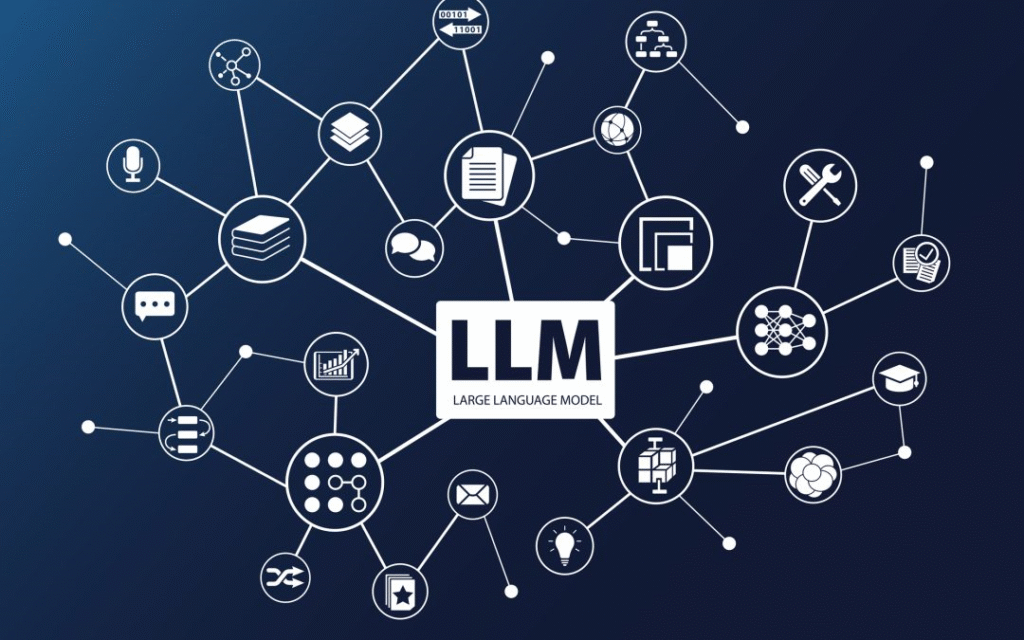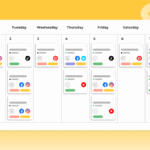The way we look for information has changed significantly in a few years. Millions of people now use AI assistants like ChatGPT, Perplexity, Claude, and Google’s AI Overviews to receive immediate answers rather than entering terms into a search engine and browsing through links. This development is altering the way that companies and marketers need to know how to optimize content for LLMs.
It’s essential to go beyond conventional SEO if you want your content to appear in these AI-generated answers. Whether the information is on your website, social media accounts, or in third-party mentions from influencers, blogs, and podcasts, you now need to optimize it for LLMs (large language models) and AI search.
Continue reading to learn how LLMs operate, how they choose which information to reference, and how to prepare your writing for AI-powered discovery. In just a few steps, this tutorial will teach you precisely how to achieve it! Let’s get started!
Tips To Optimize Content for LLMs

1. Know Your Target Audience And Intent
Adapting your content to correspond with your audience’s individual demands and search intent is a vital step in how to optimize content for LLMs. Every step of the client journey deserves a unique strategy. For instance, a top-of-funnel visitor may be seeking general knowledge, so material like listicles or blog pieces that are enjoyable, digestible, and educational perform well.
Meanwhile, someone in the center of the funnel is likely considering choices and might benefit from a comprehensive comparison guide or case study. At the bottom of the funnel, product-focused material or customer testimonials may influence a buying decision.
When your content properly represents the user’s purpose from the outset, large language models may more effectively expose it in relevant searches, enhancing visibility, relevance, and user happiness.
2. Pretraining And Fine-Tuning
Large language models are first trained on enormous datasets comprising varied text sources such as books, papers, websites, and more. This basic training step supplies the model with a wide grasp of linguistic patterns, factual information, syntax, and the links between ideas. At this level, the model develops its essential verbal and thinking skills.
However, to make LLMs more effective for particular applications, a second phase—called fine-tuning—is sometimes undertaken. This entails training the model further on specific data or adding user comments. Fine-tuning helps LLMs to become more accurate in some areas and better at obeying specific directions.
For example, a healthcare-focused LLM may be fine-tuned utilizing medical literature to boost its capacity to provide expert-level replies in that sector.
3. Make Use Of Concise, Structured, And Clear Language
LLMs thrive on clarity and organized content—just as bees are attracted to flowers. When developing material that’s both user-friendly and LLM-friendly, precise layout is vital. Use bullet points, numbered lists, subheadings, and short paragraphs to split material into manageable parts.
This not only helps readers skim and consume material rapidly but also enables LLMs to better grasp and analyze your content. Avoid unnecessary jargon or unnecessarily complex language; instead, express intricate concepts in clear, straightforward words as a way of optimizing content for LLMs.
Think of your material like a well-organized closet: everything should be in its rightful place, simple to locate, and rationally ordered. Clear content increases readability, optimizes search engine performance, and guarantees your message reaches both human readers and AI systems efficiently.
4. Retrieval-Augmented Generation
When large language models are linked to external data sources, retrieval systems play a critical role in providing correct and up-to-date information. These systems function by instantaneously extracting the most relevant pages depending on a user’s query, frequently seen in tools like Perplexity and Bing or when utilizing real-time APIs.
The acquired text is then described by the LLM, frequently with citations referring back to the original source. This procedure enables LLMs to deliver updated, reliable responses and give credit to material providers. For your material to be included in these summaries, it must be clear, well-structured, and trustworthy.
Optimizing for retrieval includes ensuring your data is readily discoverable, matched with typical search intentions, and gives high-value, authoritative insights.
5. Use Semantic SEO And Entity Optimization
Semantic SEO goes beyond merely filling your material with keywords—it focuses on meaning, context, and user purpose. Instead of repeating a phrase like “best coffee maker” over and again, expand your content with semantically relevant phrases and ideas such as “espresso machine,” “brew strength,” or “single-serve pods.” This helps both readers and large language models appreciate the complexity of your material.
Additionally, citing well-known entities—such as brand names, places, or particular tools—adds credibility and context. Even if you don’t utilize an exact search keyword, semantic relevance helps your content surface for a larger variety of relevant inquiries. This method promotes exposure, fits with the way search engines and LLMs digest material, and eventually improves your chances of reaching the correct audience.
6. Include Natural Language Questions And FAQ Sections
Users and large language models both value information that reflects real speech patterns, since it fits more closely with how people search and engage. To boost exposure and raise your chances of being included in AI-driven snippets or chatbot answers, it’s vital to add conversational language into your content. This is particularly useful when incorporating commonly asked questions (FAQs), such as “How can I clean a smart TV?”
These inquiries not only appeal to customers wanting fast, straight answers but also boost your chances of getting featured in voice search results. As more consumers use voice-activated devices like smart speakers, customizing content to suit how inquiries are asked aloud is crucial. Structuring your work with question-based headers and clear, brief replies may lead to increased exposure and interaction.
Read More: 9 Benefits of Large Language Models For Organizations
7. Use Citations And Recommendations
Large language models typically acknowledge or credit certain sources, such as Perplexity and ChatGPT with Browse, to give accurate and authentic information. Some LLMs, like Google’s AI Overviews, gather data from numerous websites to provide complete and credible replies.
To enhance the probability of your material getting picked, it’s vital to present clear, succinct, well-organized, and semantically rich information, which is essential when optimizing content for LLMs. Content that is authoritative and related to the question stands out, making it more likely to be mentioned or included in AI-generated results.
Striving to become the go-to, most credible source for a given issue may dramatically boost your brand’s exposure. When an AI model explicitly credits your material, it works as a strong endorsement, confirming your reputation and garnering more attention to your brand.
8. Optimize For Featured Snippets And AI Summaries
If you want Google to promote your material in a summary box or highlighted snippet, it’s vital to offer a straight, unambiguous response to the inquiry. Keep your answer between 40 and 60 words, using plain, easy-to-understand language. Organize the material exactly after the question, ensuring it’s brief and to the point.
This method boosts your chances of getting picked for rich snippets, since search engines emphasize information that’s clear, relevant, and highly readable. By offering an organized and readily digestible response, you’re making it simpler for search engines—and users—to locate and interact with your materials.
9. Keep Your Voice Authoritative and Consistent
Your content should align with the attributes that large language models value: clarity, accuracy, and trustworthiness. Since LLMs are trained on high-quality data, writing with these standards will strengthen your credibility. Whether your tone is casual, technical, or narrative, ensure consistency throughout the piece. Each claim should be supported by citations from reputable sources to validate your arguments.
Avoid vague terms like “might,” “could be,” or “perhaps” unless absolutely necessary. LLMs favor content that offers definitive, well-supported answers, and users prefer clear, actionable information. Writing confidently and precisely increases the likelihood of being recognized as a trusted resource by both AI systems and readers.
Some LLM Optimization Tools And Platforms
Introducing LLM-powered tools, each with a unique focus to help you know how to optimize content for LLMs more efficiently and effectively:
OpenAI: The original powerhouse. Among the top AI content authoring tools are OpenAI’s GPT models. They assist in writing customer responses, creating marketing copy, and coming up with blog ideas. This platform is adaptable enough to manage any situation in almost any sector.
Claude: Meet the considerate person in the group. Anthropic’s Claude is all about ethical AI. It excels in situations requiring material with subtlety, consideration, and an ethical compass, such as in-depth analyses, delicate subjects, or editorial work that calls for a personal touch without going too far.
Jasper: Your quick-witted, deadline-driven copywriting partner. Jasper assists you in transforming concepts into well-written, conversion-ready content that adheres to the tone and language of your business. For businesses that want anything from powerful social media captions to in-depth blog posts, making it an ideal tool for future content marketing.
SurferSEO: Designed to help your content stand out in search results, SurferSEO is the AI for SEO content. It directs your structure, examines the competition, and suggests high-performing keywords to help you get that desired top Google ranking.
These LLM platforms simplify the process of optimizing your approach for both AI and humans.
FAQ
Q: What effect do LLMs have on content strategy?
A: LLMs upend your content strategy by enhancing its relevancy, speed, and quality. They make your process quicker and more effective, let you customize material to your audience’s search terms, and provide SEO-friendly adjustments.
Q: Which methods work best for matching content to LLMs?
A: Examine your current material and identify areas where it might be made LLM-ready. Make your information easy to skim, concentrate on what people are looking for, and use straightforward, organized language. To make your information stand out, use images, real-world examples, and frequently asked questions.
Q: Which errors are often made in LLM content strategies?
A: Avoid these frequent mistakes: over-stuffing your material with keywords, making it too complex, or completely neglecting SEO. You may also make mistakes by not maintaining a consistent voice or by not modifying your material in response to AI input. Always focus on what your audience (and AI) wants, and keep it simple and relevant!







